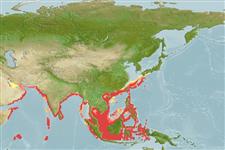>
Scombriformes (Mackerels) >
Scombridae (Mackerels, tunas, bonitos) > Scombrinae
Etymology: Scomberomorus: Latin, scomber = mackerel + Greek, moros = silly, stupid (Ref. 45335).
More on authors: Bloch & Schneider.
Environment: milieu / climate zone / depth range / distribution range
Ökologie
seewasser; brackwasser; ozeanodrom (Ref. 51243); tiefenbereich 15 - 200 m (Ref. 9684), usually 20 - 90 m (Ref. 12260). Tropical; 38°N - 7°S, 49°E - 134°E (Ref. 54881)
Indo-West Pacific: Persian Gulf, India and Sri Lanka (Ref. 9684) to southeast Asia, north to Hong Kong and Wakasa Bay, Sea of Japan.
Length at first maturity / Size / Gewicht / Alter
Maturity: Lm 39.8, range 33 - 46.5 cm
Max length : 76.0 cm FL Männchen/unbestimmt; (Ref. 168); common length : 55.0 cm FL Männchen/unbestimmt; (Ref. 9684)
Rückenflossenstacheln (insgesamt): 15 - 18; Rückenflossenweichstrahlen (insgesamt): 18-24; Afterflossenstacheln 0; Afterflossenweichstrahlen: 19 - 23; Wirbelzahl: 47 - 52. Interpelvic process small and bifid. Swim bladder absent. Body entirely covered with small scales. Lateral line with many auxiliary branches extending dorsally and ventrally in anterior third, curving down toward caudal peduncle. Intestine with 2 folds and 3 limbs. Sides silvery white with several rows of round dark brownish spots scattered in about three irregular rows along the lateral line. First dorsal fin membrane black.
A pelagic migratory fish inhabiting coastal waters at depths between 15-200 m; sometimes entering turbid estuarine waters; usually found in small schools (Ref. 9684). Feeds mainly on small schooling fishes (especially sardines and anchovies), squids and crustaceans (Ref. 9684). Fishing peaks in the months of November and December in Eastern Thailand, late Dec and January in the northern part of the Gulf and January to March in its western part. Caught with midwater trawls, purse seines, bamboo stake traps, and by trolling (Ref. 9684). Marketed mainly fresh; also dried-salted (Ref. 9684), smoked and frozen (Ref. 9987). Small quantities of frozen product are exported to Europe and North America (Ref. 9987).
Collette, B.B. and C.E. Nauen, 1983. FAO Species Catalogue. Vol. 2. Scombrids of the world. An annotated and illustrated catalogue of tunas, mackerels, bonitos and related species known to date. Rome: FAO. FAO Fish. Synop. 125(2):137 p. (Ref. 168)
IUCN Rote Liste Status (Ref. 130435)
Bedrohung für Menschen
Harmless
Nutzung durch Menschen
Fischereien: hoch kommerziell; Sportfisch: ja
Mehr Information
PartnerBilderStamps, Coins Misc.LauteCiguateraGeschwindigkeitSchwimmstilKiemenoberflächeOtolithsGehirngrößeSehfähigkeit
Tools
Zusatzinformationen
Download XML
Internet Quellen
Estimates based on models
Preferred temperature (Ref.
123201): 23.6 - 29.1, mean 28.2 °C (based on 1618 cells).
Phylogenetic diversity index (Ref.
82804): PD
50 = 0.5000 [Uniqueness, from 0.5 = low to 2.0 = high].
Bayesian length-weight: a=0.00776 (0.00636 - 0.00948), b=3.02 (2.98 - 3.06), in cm total length, based on LWR estimates for this species (Ref.
93245).
Trophic level (Ref.
69278): 4.3 ±0.67 se; based on food items.
Widerstandsfähigkeit (Ref.
120179): mittel, Verdopplung der Population dauert 1,4 - 4,4 Jahre. (K=0.18; Fec=385,000).
Prior r = 0.57, 95% CL = 0.37 - 0.85, Based on 1 stock assessment.
Fishing Vulnerability (Ref.
59153): Low to moderate vulnerability (30 of 100).
Climate Vulnerability (Ref.
125649): High to very high vulnerability (75 of 100).
Nutrients (Ref.
124155): Calcium = 41.3 [19.2, 151.1] mg/100g; Iron = 0.944 [0.441, 2.337] mg/100g; Protein = 20.8 [19.6, 22.0] %; Omega3 = 0.322 [0.196, 0.526] g/100g; Selenium = 68.4 [25.0, 346.7] μg/100g; VitaminA = 18.4 [3.8, 84.9] μg/100g; Zinc = 0.829 [0.552, 1.315] mg/100g (wet weight); based on
nutrient studies.
